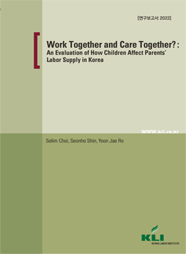한국노동연구원 'Publications in English'에 대한 설명 입니다.
Publications in English
Publications in English

Work Together and Care Together? : An Evaluation of How Children Affect Parents’ Labor Supply in Korea
- Author Selim Choi , Seonho Shin , Yoon Jae Ro
- Publication Date 2022.12.30
- Length 124
- ISBN 979-11-260-0605-2
Content
Chapter 1 Introduction
Chapter 2 Motherhood
and the Labor Market Penalty: Discussion on Perceptional Change
Chapter 3 Effect of
Increased Demand for Childcare Time on Parents’ Allocation of Working Hours
Chapter 4 Mothers’
Selection into Work in South Korea
Chapter 5 Conclusions
Summary
The South Korean (hereafter Korean) government has called for the creation of a society where mothers and fathers work and care for their children together in its recent Low Fertility-Aging Society (LF-AS) strategic plans (revisions to 3rd and 4th plans in 2018 and 2020, respectively). Before then, policies aimed at tackling the downward fertility trend focused narrowly on inducing women to have more children.
The government’s recent
shift in focus, however, has not been adequately supported by empirical works
investigating the relationship between children and parents’ labor supply in
the Korean context. In the previous policy approaches to the low fertility
problem, policy makers did not consider the relationship between fertility
choices and parents’ labor market participation and outcome comprehensively.
Even though this change
in policy direction seems reasonable in the face of the extremely low fertility
rate and expected shortage of workforce in the near future in Korea, we need a
clear picture of the status quo and to identify the areas requiring government
intervention based on quantitative analyses.
To help broaden the insights into the relationship between parenthood and labor market participation, we propose an empirical analysis of three different topics related to children and parents’ labor supply, using recent data from various sources.
 Source Indication + Commercial Use Prohibition + Change Prohibition
Source Indication + Commercial Use Prohibition + Change Prohibition